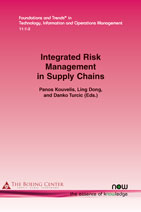Managing Supply Risk in Fixed Price Contracts: A Contingent Claims Perspective
By Bardia Kamrad, Georgetown University, McDonough School of Business, USA, kamradb@georgetown.edu | Ran Ji, George Mason University, USA, rji2@gmu.edu | Glen M. Schmidt, The David Eccles School of Business, University of Utah, USA, glen.schmidt@business.utah.edu
Abstract
The primary focus of this paper is supply risk mitigation. though, its objectives are twofold. First, we develop a generic contingent claims model framed as an exercise in stochastic optimal control. The model is easily adjusted to a number of risk-based operational problems. Second, we adapt the model to the problem of supply uncertainty and the valuation of a fixed price contract with a focus on managing supply uncertainty through a portfolio based risk sharing framework. The risk and reward tradeoffs characterizing our general findings in this chapter indicate a subtle balance between supply risk, sourcing allocations and related costs, and accordingly, the resulting operational strategies considered. Given this setup, increased supplier-portfolio risk is a defining measure in establishing optimal operating policies, with the caveat that increases in the supplier portfolio’s volatility, also increase shortages which lowers the contract’s value.
Integrated Risk Management in Supply Chains
Integrated Risk Management in Supply Chains examines supply chain risk management. The increased interest in the topic is due to a number of factors including the increased volatility of commodity prices and exchange rates, recent natural disasters, and the increased importance of multinational corporations. The motivation for risk management comes from a variety of sources: financial distress costs, managerial incentives, and other important reasons discussed in the remainder of this book. Understanding the motives is important because they provide insights into which risks should be managed and how a firm’s risk management operations should be organized.
The first part examines Buffering Supply Chain Risk with Operational Flexibility and deals with uncertainty in the form of routine variability, which includes fluctuations in demand. Part 2 reviews Supply Disruption. Both the preponderance of natural disasters and huge economic swings can cause extreme challenges across the supply chains. Although these types of risks are rare, they are highly consequential and buffering is insufficient to mitigate them. Instead, firms facing these risks must engage in contingency planning and must maintain redundancies in the system. This is why contingency planning is on the interface of operations and finance. Part 3 looks at Commodity Price Risks, which includes five papers on managing price risks – the first three papers are fundamental in that they ask “when” and “how” firms should manage price risks with hedging and how hedging affects operating policy and the remaining two papers examine the best practices in specific industries.

Companion
Foundations and Trends® in Technology, Information and Operations Management, Volume 11, Issue 1-2 Special Issue: Integrated Risk Management in Supply Chains
See the other articles that are also part of this special issue.